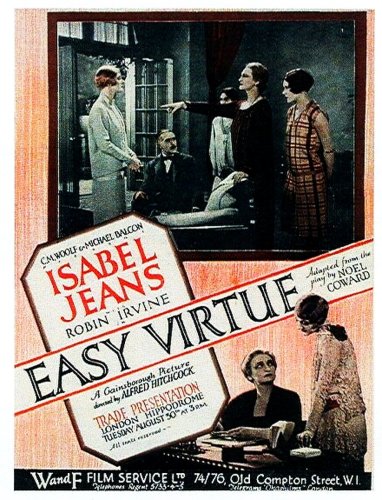

While sitting with Larita after she is hit with the tennis ball, John's sitting position changes between shots.
When Larita's hurt face is being tended to by a nurse, Larita's hand jumps from being in her lap to near her face between shots.
John's distance from Larita changes dramatically after she shakes shaking her cocktail at the another table then suddenly is next to Larita's table.
When Sarah and Larita first meet, John stands in between them.
But in the next shot he is shown on the far left of the girls.
After talking to his mom about Larita and sitting next to Sarah, John's leg and arm positions change between shots.
When the three men are talking together at the horse track, the people standing in the background change positions then disappear in subsequent shots.
Isabel Jeans was a well known British actress of stage and screen. In Sir Alfred Hitchcock's silent screen adaptation of Sir Noel Coward's play, "Easy Virtue.
The Verdict This is a British movie and not your typical Hollywood fast food production. Worth checking when just relaxing is not your only objective as some mind and soul effort might be required.
The movie 'Easy Virtue' was released in 2008. Production began with 14 million dollars.
Divorces were getting popular in the 1920s - yes they were happening - but it was still a taboo subject for some people to talk about or even accept as being "okay". Films like this one were made with the taboo subject of divorce in mind to help bring divorce to mainstream discussion and acceptance.
Easy Virtue is one of Hitchcock's interesting but not great films, that is neither among his best or worst. Not a terrible one but this is really not the master of suspense at his best.
Alfred Hitchcock was the most exciting directorial find to come out of British cinema in the 1920s but even though "The Lodger" was an atmospheric, moody thriller of things to come, the Hitchcock of the twenties and early thirties tried his hand at a number of styles. Before Hitchcock, British cinema was in the doldrums - it's most prestigious film had been "The Rat", heavily inspired by German Expressionism and with an attempt to capture some of D.
The premise of the story is that a woman, the gorgeous Larita, is caught in a scandal when she is divorced from her husband (he was a drunk louse, and the 'Easy Virtue' name comes from the sort of scandal at the time: she went into another man's arms, an artist who cared for her, and then he got into a big fight that ended with a gun going off).In other words, she was found guilty and found a "Correspondent" or whatever that means, so she decides to high tail it to the Mediterranean/South of France and happens to meet a nice young man, John, who just falls head over heels for her...
Classic Hitchcock.
A shockingly uncompelling plot of a woman's history coming back to haunt here...only her past isn't that bad, the people judging her are implausibly over-critical, her husband is a scared fish of a man, and the entire culture of this world seems interested in this story for no good reason.